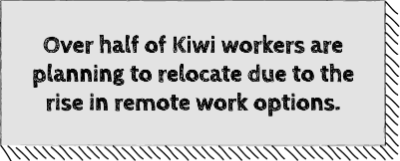The current recruitment market is particularly challenging for employers, making traditional recruitment approaches less effective without some additional innovation. To stay competitive in New Zealand’s increasingly talent-short market, looking beyond convention could be the key to finding the people you need.
Remember, there is no such thing as the 'perfect' recruitment strategy for all organisations. Each company's recruitment efforts are affected by their employer brand, budget, location, industry, company culture, flexible work options and more. Recruitment strategies are also subject to frequent changes due to various project pipelines, the time of year and the urgency of the hire.
With this in mind, we're not going to prescribe a specific way to recruit people or suggest gimmicks. Instead, we'll cover some real-world examples of companies getting creative with their approach to recruiting top talent and achieving success. Their ideas might give you the inspiration you need for creating new recruitment strategies to attract and retain key employees.
Find Ways to Customise Roles for the Best Outcomes
If your organisation is finding it particularly difficult to hire for a specific role, think about how you could make small adjustments to the role or even the team in order to secure the right talent, while still keeping the big picture in mind. One of our medium-sized clients in the health sector did just that, and achieved an important result for its long-term future.
Our client had enlisted us to recruit an Intermediate Developer, but no candidates were available that fit the requirements. (In recent years, recruiting for intermediate roles has become harder in some cases, as employers have vastly improved staff retention efforts.) The only suitable candidate available was over-qualified for the role, so our client was concerned about not being able to retain that candidate in the long term.
The client decided to make the role more appealing to this senior candidate by giving him an opportunity to mentor someone – so they hired a junior employee alongside the intermediate developer. Creating a junior role also helped the client build a succession plan in the event that the senior candidate moved on.
Consider how you can make changes within your roles or teams to make them more appealing to top talent, while serving the long term needs of your business.
Use Flexibility to Attract People
As more professionals have become comfortable with working from home, making your organisation and roles WFH-friendly can significantly broaden what is otherwise a narrow pool of IT talent. More companies are realising this and starting to offer fully remote work options so they can hire from anywhere in New Zealand. Having employees come into the office just one day per week is also becoming common.
Even employers in the major centres are increasingly offering WFH options, especially for software development roles. A strong appetite to maintain onsite team culture remains within some companies, but for employers outside the major centres, this requirement might exclude the only suitable candidates interested in the role.

Among candidates, the desire to be untethered from the office has strengthened during the pandemic. Research from Microsoft New Zealand found 56% of workers were planning to move to a new location in 2021 because of remote work options.
After losing a Senior Developer to a competitor, a small software house recently solved its hiring problem by making a key role more flexible to attract candidates. The business had exhausted all avenues for finding a suitable replacement, while the only applicants interested in the role were completely unsuitable. With no seniors available in the team to carry out the work and no team capacity to mentor a Junior/Intermediate Developer, a new approach was needed. The organisation decided to make the role 100% WFH, while staying within budget. As a result, the company successfully secured a Senior Developer who could tackle the work without being a drain on the existing team.
Meanwhile, when recruiting a senior management role, one of our larger clients opted for an alternative strategy: not specifying the type of employment. The organisation was open to Contract, Permanent or Fixed Term Contract candidates, which resulted in a strong response. They were able to interview a wide variety of candidates and select the candidate best suited for the role.
Create a Four-Day Work Week to Beat Rising Salary Costs
Salaries and salary expectations have skyrocketed in recent months, leaving many organisations unable to afford current market rates for key roles. With the borders closed, candidates with the most scarce skill sets (such as DevOps and Salesforce Developers) are receiving job offers with unusually large salary hikes. It's now common for these professionals to be juggling multiple job offers with increases of $30,000-$40,000 or more above their current salary.
If you are recruiting for a role with a budget well below current market rates, consider offering candidates a four-day work week to make up for the shortfall in salary. One of our government sector clients was struggling to retain employees and found themselves repeatedly losing candidates to higher offers and counter offers. For a Senior Business Analyst role, the highest salary our client could offer was $20,000 less than a competing offer. In response to this challenge, the company decided to consider candidates who would accept the lower salary in return for a four-day work week.
Adjusting to fewer working days per week has provided numerous benefits for organisations. New Zealand financial services company Perpetual Guardian observed a 20% gain in productivity after introducing a four-day week, while Microsoft Japan increased productivity by 40% and reduced electricity expenses by 23% with a similar policy.
Below, we’ve broken down the hourly rates and salaries we’re currently seeing for a variety of tech roles to give you an idea of what competitive pay might look like in this market, and where you may need to consider supplementing with other perks.

Work on Attracting Passive Candidates
Effective recruitment often includes targeting passive candidates – those who are not actively looking for a new role but will consider changing jobs if approached about a specific opportunity. Many employers find that suitable candidates these days are, for the most part, simply not searching for new roles. To win over passive talent, it's vital to make the recruitment process as frictionless as possible.
Although passive candidates can be a goldmine, clear and quality communication is essential for fuelling their interest and making them feel invested in the recruitment process. If someone is approached by a recruiter for a role, they will expect to learn as quickly as possible what's in it for them. As recruiters, it is therefore essential that we understand our clients' WFH options, career progression opportunities, project involvement, remuneration and benefits, so we can sell the role to passive candidates in the best way possible.
Further, passive candidates won't stick around for drawn-out recruitment processes with too many steps, as they will likely be handling approaches and offers from multiple organisations – all whilst tending to their current commitments. Speed and efficiency are necessary to prevent these candidates from withdrawing from the process.
When approaching a passive candidate, especially one who is not local, it's important to know what their obstacles are in changing roles. Many of our clients have had talented senior employees poached from overseas companies offering to pay them for relocation expenses. The current rates of relocation payments range from $3,000-$5,000 within New Zealand, with bonuses offered over the ditch being significantly higher.
Are you struggling to find local candidates, or wondering how to attract talent from competitors? Consider using a sign-on bonus or relocation costs to help attract those who are putting relocation in the too-hard box. Even for candidates who have never before considered moving overseas, being offered a great job on a platter with relocation costs covered plus a sign-on bonus is likely to make the decision at least very tempting. Most importantly, it can make the conversation with their significant other much easier.
Loosen Requirements Where Possible and Hire for Talent, Not Skills
The truth for many organisations is that they're experiencing a skills shortage, not an actual talent shortage. When the perfect candidate is simply not available in a particular market, organisations can expand their options by removing some hard criteria. By considering individuals who might not tick all the boxes, you can still find people with core skillsets and great potential for learning specific skills.
Remember, the most important transferable skills – such as industry knowledge, leadership skills, communication ability, creative and analytical thinking, teamwork and collaboration skills – are not always obvious on an individual's CV.
For example, one of our clients was looking for a .Net Developer with Angular skills, based on the North Shore in Auckland. However, the best candidate we found was unwilling to work for a company based on the North Shore. After changing its criteria, the organisation eventually found a talented and eager Backend Developer who was attracted by the offer of training in Angular.
Another client, based in Hamilton, needed a Backend .Net Developer. Although we found a candidate with strong skills in this area, they were unwilling to travel to that location. This client decided to re-tool the position to make it more appealing to a Full Stack Developer.
When searching for specialist talent, such as Project Managers, Business Analysts and Testers, consider how much of their skillset is non-negotiable for the role and which technical skills they could acquire on the job. Working with experienced Technology, Transformation & Digital recruiters and using sensible assessment methods helps organisations identify the talent with the best future potential.
The Takeaway
Recruitment in talent short markets is always a challenge without careful planning, so the first step is to be informed about what the best talent is currently looking for in similar roles. Researching current market trends and gathering feedback from candidates and hiring managers can help inspire new ideas for recruiting people successfully.
Think about how you can adjust a position or job offer in ways that make your organisation stand out from the competition – it's ultimately about putting people first and thinking about the big picture. For specific advice on what your business can do to find new talent, our team of Technology, Transformation & Digital recruitment specialists are happy to share their expertise and market knowledge to help uncover your next solution. Get in touch with us today to find out more.





